World market and production of armored vehicles (part 3 of 3)
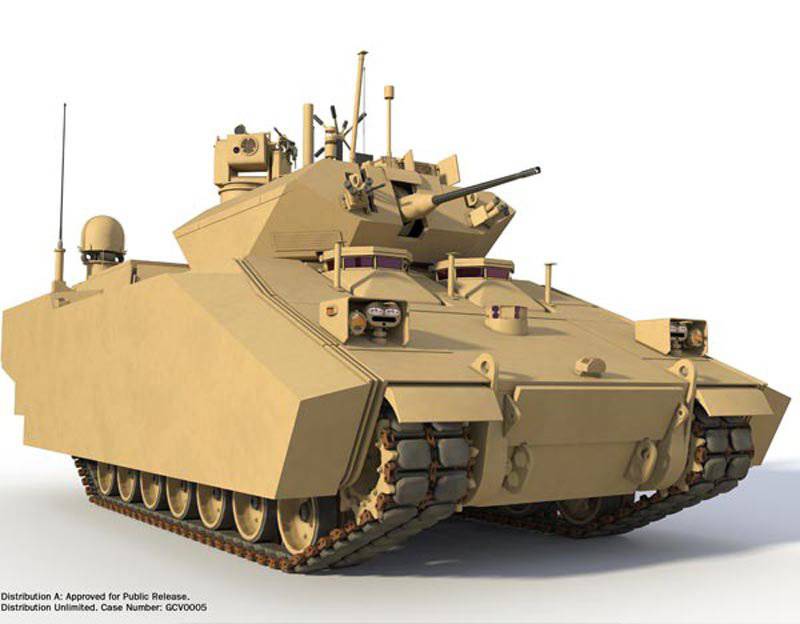
Ground Combat Vehicle (GCV)
Compared with several years earlier, when the wheels were very popular, 2013 passed the year under the sign of a return to the tracks, despite the higher cost of their operation. One program can undoubtedly change the future of tracked infantry fighting vehicles: after the program "Combat Systems of the Future" is closed, the American army still has no substitute for the Bradley family, the birth of which dates from the 70 years of the last century. Therefore, after forty years, given the urgent need for such a replacement, the project on ground combat vehicle Ground Combat Vehicle (GCV) must be expected to survive the current sequestering. Another significant American program is the Armored Multi-Purpose Vehicle (AMPV) multi-purpose armored vehicle program, which should replace all support vehicles based on the M113 chassis. However, in this case, the dramatic choice between tracks and wheels is still ahead.
The decision to issue a contract for the development of a technology sample of approximately 450 million to BAE Systems and General Dynamics Land Systems (GDLS) companies dates back to August 2011. “Faster, lighter, more economical alternatives” Bradley is what Army Chief of Staff General Eric Shinseki announced in 1999 as requirements for new machines. After almost 15 years, his wishes for a light BMP did not become a reality, the current predicted weight of the Ground Combat Vehicle is more than twice the mass of the Bradley BMP in its original version. In addition, due to recent cuts in the defense budget, a decision on the production of GCV may not be made through 20 years after General Shinseki’s speech. By that time, the first Bradley machines will be in operation for over 35 years, but if everything goes well, the army hopes to get its first GCV production cars in 2017. The decision to delay (at least six months) the development stage of the technological sample due to budgetary pressure was announced at the end of January 2013. As a result, the request for proposals on the stage of final development and introduction into production, originally planned for the autumn of 2013, was postponed to the spring of the year, 2014. Another solution, which runs counter to the army’s desire on a competitive bid, concerns a reduction in the number of contractors at this stage to one. However, according to some estimates, this decision will help save approximately 4 billion dollars in the next five years. What remains unchanged today is the requirements for the car, which must accommodate three crew members plus a squad of nine soldiers, be well protected and fully networked, and also have a power plant with significantly lower fuel consumption.
Under this GCV program, BAE Systems has teamed up with Northrop Grumman and this team is in fact the only applicant to reveal some details of their proposal. Probably starting with the problem of mass, the first M2 Bradley had a combat mass of 22,6 tons and accommodated three crew members and seven paratroopers, and its proposed successor (according to the company's prospectus) will have a lot of 63,5 tons and more.
Admittedly, the Bradley BMP was criticized for its relatively weak defense, which led to several upgrades, as a result of which the combat mass of the latest Bradley A3 variant was 34,3 tons. The new power plant should provide good mobility and a small increase in the maximum speed of 70 km / h (the M2A3 variant develops the 61 km / h). The company BAE Systems decided for the GCV project to adopt its new hybrid electric propulsion system. It received the designation Traction Drive System (TDS) and was developed jointly with the firm QinetiQ, which provided a key component for TDS - the EX-Drive transmission. TDS can be installed on 20 - 40 tons of vehicles and is based on two symmetrical power units, which increases reliability and provides limited functionality that is not available in single engine configurations.
It is believed that TDS is at the level of technological readiness 6 - 7 (completion of the prototype), and BAE Systems has published presentation materials with some characteristics of the new installation. Its power is 1500 hp. corresponds to the parameters of modern combat tanks (but also the mass of the new machine will correspond to the mass of the tank). However, the hybrid drive, in which the final stage is performed by electric motors, offers several advantages. In addition to less penetration into the architecture of the car, fuel savings of 10% to 20% are claimed, which means a range of 300 km with a full fuel tank of 965 liters (compare with the M2A3, which travels more than 402 km at 662 liters, but weighs half as much) . Take a modern 70-ton tank as the criterion; it will burn about 55600 liters of fuel in a 180-day campaign. A new type of machine with the same weight, but working on a mechanical power transmission can use up 39700 liters, but the same machine with a power unit BAE Systems TDS will use up 33235 liters, in other words, almost 6500 liters less. This means that three cars will save the equivalent of two M948 HEMTT fuel tanks. The high torque of the electric motors increases maneuverability at low speeds, and during urgent operations, the hybrid configuration allows the machine to move silently. As noted above, the increase in maximum speed with the new hybrid installation is not very large (not the main issue from an operational point of view), but at the same time, the acceleration increases by 25% due to again the large moment of electric motors; while the car accelerates from 0 to 32 km / h in 7,8 seconds versus 10,5 seconds for a regular 70-ton machine.
The QinetiQ EX-Drive transmission also provides seamless switching between all driving modes. In addition to silent operation, another key advantage of TDS is the presence of an electric generator with an 1100 kW power, which is sufficient to provide all future subsystems with a margin. The BAE Systems-Northrop Grumman GCV will have 7 track rollers with hydropneumatic suspension and tracks 635 mm wide.
According to one estimate, the GCV mass can reach 84 tons, although some believe that the issue is still open and you need to wait at least until next year to have a clear idea of how the American Army 2020 BMP will look like.
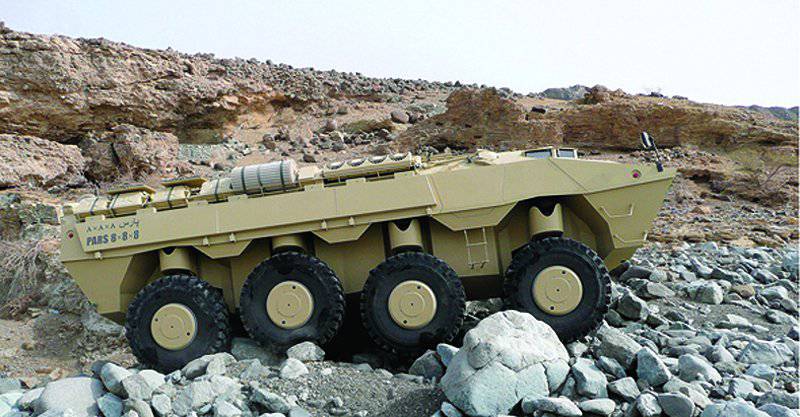
BTR PARS 8 x 8 was conceived, designed and manufactured by Turkish engineers at the factories of the company FNSS. The company has spent over U $ 20 millions of own funds to develop the PARS family of machines
Fig. 10: Armored vehicles in Latin America
Latin America
The Armed Forces in Latin America have a total 11572 stock of armored vehicles, which have remained almost the same since 1998, but with different levels of development in individual countries. With the growing importance of the Latin American market for the local and foreign defense industry, new companies have begun their activities in the field of ground systems: the construction of a national defense industry is a major component of security strategies in many countries.
Increasing the tactical and strategic mobility of the Armed Forces and acquiring a family of new armored wheeled vehicles are important objectives of the Brazilian defense strategy. The Brazilian Defense Ministry and IVECO Latin America, supported by the Italian IVECO Defense Vehicles, signed a contract in December 2007 to develop a platform for the VBTP-MR 6x6 personnel transporter. Since April 2010, the first prototype was tested by the Brazilian army, followed by the production and testing of more 16 machines. 18 December 2009, the Brazilian army has signed a contract to supply 2044 units of the basic VBTP-MR model worth approximately 2,5 billion euros.
The Brazilian Marines ordered 30 floating machines PIRANHA NIC 8 x 8 in three batches from Mowag. The Brazilian company Agrale, a manufacturer of trucks and engines, developed the AGRALE MARRUA 4 x 4 light machine in various versions and delivered the first vehicle to the Brazilian army in August in 2008. The 4 x 4 GAUCHO light machine was developed by the Brazilian Army Technology Center in cooperation with Argentina. Avibras Aeroespacial manufactured the ASTROS II rocket launcher and manufactures armored vehicles. Brazilian defense production and national security industry is becoming a global partner of the armed forces of foreign industry.
Brazil is also considering an 8 × 8 armed with an 105-mm cannon as a replacement for the EE-9 Cascavel and Sk105 light tank, a request for information was sent to the manufacturers of the towers. Four companies responded to this request, Oto Melara with Hitfact 105, the Brazilian Ares Aerospacial e Defesa division of Elbit Systems with its MT 105BR, CMI Defense with the CT-CV 105HP tower and Tarobá Engenharia with an unnamed offer. The request for proposals was released at the end of 2013 of the year, at the same time a contract was signed between the Brazilian army and Iveco Latin America to create a version of the Guarani 6 × 6 machine in the 8 × 8 configuration.
Chile received the 140 LEOPARD 2 and 207 BMP MARDER from the German army. Chilean company Fabricas from Maestranzas del Ejercito, FAMAE, is involved in the maintenance and logistics of these machines.
The Peruvian army has been trying to replace its outdated T-55 since the end of the 90-s. The last serious attempt to buy Xinchx Chinese tanks Norinco Type 80-II failed in 90 year. Local sources indicate that approximately of the 2009 T-249s in service with Peru, only 55 tanks remain on the move. However, the T-70C is viewed as a competitor to the former Dutch tanks Leopard 90A2 and the new Ukrainian T-6 Stronghold.
Asia
In Asia, security policy is not determined by a comprehensive regional approach. The security situation and the armored vehicles market are subject to a significant increase in the military power of China and India, an increase in military spending, a change in military doctrines towards closer participation in international peacekeeping operations, an increased buildup of national defense industries and the intensification of arms exports.
Stocks of armored vehicles account for 73530 units in Asia, with the largest percentage of 29075 MBT units (39,5%), in spite of other regions of the world. Many Asian countries like South Korea, Singapore, China, India, Pakistan and Japan have created powerful industries for land systems and successfully export their products, with the exception of Japan due to constitutional restrictions (which were successfully removed this year).
South Korea
The army of South Korea is armed with 1027 tanks K1 and 484 tanks K1A1 and this year should receive its new machine K2, also known as the Black Panther. Hyundai Rotem has already received an order for 100 Black Panther tanks and it is expected that approximately 500 machines will be manufactured. While the K1A1 version gained increased firepower thanks to its 120 / 44 bore gun, compared to the 105-mm gun of the original K1, the K2 version went one step further and got the 120 / 55 gun, which differs in increased initial speed and advanced initial speed and Chrome and XNUMX cannon.
In the new tank in the aft niche of the turret (tourney), an automatic loader was installed with 16 ready shots from 40 shots in combat pack. The MTU 883 engine's power is 1500 hp, the combat weight of the K2 55 is tons (slightly more than the K1A1), but the new tank has a much higher power density than 27 hp / t. The power unit of local production can be taken in perspective. Hyundai Rotem is also active in the export market and in the fall of 2013, it offered Black Panther Peru, the package of proposals included the assembly of 110 tanks on the local line and other offsets.
The Korean company Doosan made about 1000 BMP KIFV. Serial production of new K21 NIFV is in full swing, deliveries of 500 machines are planned starting from the end of November on 2009, with the aim of gradually replacing the current KIFV fleet.
Samsung Techwin manufactures 155-mm SG K9 THUNDER, K10 ARV ammunition replenishment machine (Ammunition Resupply Vehicle) and K77 Fire Direction Center Vehicle fire control station. Turkish 47-ton 155-mm SG FIRTINA is the fruit of Turkish-Korean cooperation based on SG K9. Both systems have an MTU MT 881 Ka-500 motor 700 kW. The Turkish army is about to buy 336 artillery systems.
Three Korean companies with different concepts compete for the South Korean program on the 6x6 armored vehicle: Doosan Infracore with the new BLACK FOX; Hyundai Rotem with KW2 8 x 8; and Samsung Techwin with its MPV
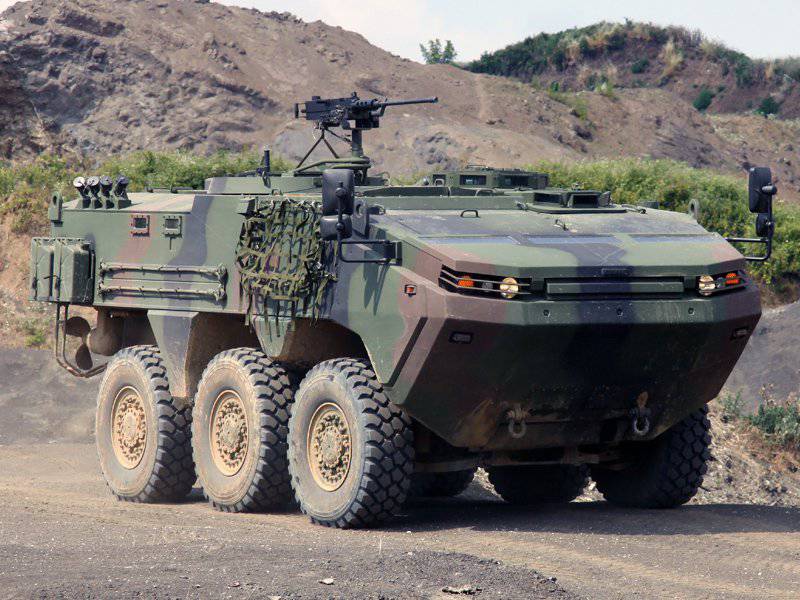
The leading Turkish ground systems manufacturer, Otokar, received the first contract for its new ARMA 6x6 tactical armored vehicle from abroad. The contract is valued at over 10,6 million dollars, including cars, parts and training. Deliveries under this contract are expected to end in 15 months
Japan
Japan has a powerful armored vehicle industry. As the main contractor, Mitsubishi Heavy Industries has manufactured the Type-90 OBT, which has a Mitsubishi 10ZG10WT 32-cylinder engine with an X-power kW kW automatic transmission and a Mitsubishi MT1100 automatic transmission. However, the main disadvantage of the Type 1500 tank was its mass of 90 tons. Although it was not more than the mass of many of his contemporaries, but such a mass was incompatible with the Japanese roads and railways, which limited its strategic mobility and transportation in the home theater of military operations. Thus, the Type 50 tank in many cases could not be transported along the roads of Japan and as a result of this and similar problems, the deployment of most of the 90 Type 341 tank made is limited to the northern island of Hokkaido, where they are not limited to maneuvering them.
Based on the experience gained, it was decided to start developing another tank with similar characteristics, but from a strategic and operational point of view, more mobile than a Type 90 tank. Research on this tank began around the year of 2000, and by the year 2008 a presentation of the prototype was made, and after 4 of the year, an order was placed for a production batch of 13 tanks. To date, some more machines have been manufactured (not disclosed) and it is assumed that, in the end, the Type 10 will replace the remaining Type 74 tanks and some of the Type 90 tanks. After which, as expected, the total number of tanks in the Japanese army will be reduced to about 300 units.
Essentially, Type 10 can be described as a reduced and refined version of Type 90. It is armed with the same 120-mm cannon L44 smooth-bore cannon, the ammunition supply mechanism is located in the stern niche of the turret, the crew consists of three people. It also has an adjustable hydropneumatic suspension, and a more modern, albeit less powerful power unit with a four-stroke V8 diesel engine with an output of about 1200 hp.
Other improvements include the transfer to another location of the commander’s panoramic periscope to provide a circular view, complemented by surveillance devices located around the tower, and the installation of the most up-to-date on-board information management system.
Type 10 protection, like Type 90 protection, includes ceramics and, in addition, the newest high-strength nanostal. The tank has a modular design, which allows for the purpose of transportation to reduce the weight from the maximum 48 tons to about 40 tons. In addition, in order to reduce the mass and center of gravity, it was decided to protect the upper part of the tank with lighter armor. In addition, due to the installation of five support rollers instead of six, like in a Type 90 tank, the weight was still reduced, although this led to a slight increase in the average maximum pressure and, as a result, to a certain loss of ride quality on difficult, soft ground.
Singapore
The Singapore Army ordered a new BIONIX II BMP from Singapore Technologies Engineering, this BMP was introduced in 2006 year. It has a combat mass of 23 tons, includes C4I technology, is equipped with an 25-mm gun and can carry up to 10 soldiers. This floating machine has an 350 kW engine and is transported in a C-130 aircraft. The company produces 36 155-mm SG PRIMUS for the Singapore Army. The crew of the 4 man, the combat weight of 28,3 tons, the engine Detroit Diesel power 404 kW. It can be transported in an A400M aircraft.
The floating TERREX 8x8, developed by Singapore Technologies Kinetics, has a combat mass of 24 tons and can carry up to 14 soldiers. With an engine on the 330 kW, it can reach speeds of almost 110 km / h. The car was officially put into service in August 2009 of the year and at least 135 machines were mass-produced.
China
Norinco (China North Industries Corporation) is the largest defense company in China. It strengthens cooperation, especially with the third world countries: there are close ties with Pakistan, especially in the development and production of AL-KHALID MBT. Norinco manufactures MBT types T-69II, T-80II, and T-85II. The newly developed OBT Type 90-II weighing 48 tons has an 882 kW engine, 125-mm smooth-bore gun, automatic loader and improved protection. In addition, the WZ-501 BMV, the WZ-506 CSR, the WZ-505 sanitary version, the newly developed WZ551B 6 x 6, and SG Type-85 are manufactured. New models are MBT-2000, 155-mm SG PLZ45 and 122-mm howitzer SH2 mounted on a wheeled vehicle.
The Chinese Armed Forces today are armed with more than 7000 MBT. Even if Norinco based in Beijing regularly announced the delivery of new MBTs, the information would be unreliable as to whether the weapons are intended for export or when the new models will actually go into service with the Chinese ground forces. The first prototypes of the OBT Type 99 were completed at the end of 1999; Since then, several prototypes have been made in various configurations (installation of weapons, jamming lasers, active protection systems), as well as under different designations (Type 99 A2, ZTZ 99 G, etc.). To date, the beginning of mass production has not been announced. Based on the long-term development stage, Western experts suggest that the tank is currently being mass-produced.
India
Due to the fact that the Indian economy has shown significant growth in recent years, it now seems to have significant financial resources to invest in its defense sector. After purchasing the 657 MBT T-90, some of which were assembled at the Heavy Vehicles Factory (HVF) in Avadi, primary documents appeared in 2007, which reinforced the MBT requirement 2020. In the end, a decision was made on the scandalous MBT program ARJUN (the duration of the development of 37 years!), The work on MVT 2020, apparently, were stopped. Instead, the second batch of ARJUN 124 tanks will be procured to ultimately equip two tank regiments with this model.
The new tank Arjun Mk II was shown at the New Delhi parade in honor of the national day in January 2014. This is a modernized version of the original Arjun, developed in the last decade by the organization of defense research and development in India. MkII was the result of a series of 89 improvements requested by the army, of which 15 should be considered separately, as they relate to the field of ammunition. The new tank weighs seven tons more than the 60-ton Arjun Mk I, in the pictures from the parade we see the installed dynamic protection in the front of the tower and on the sides of the remote-controlled module armed with an 12,7-mm machine gun.
The service life of the gun was significantly increased, in addition, the Mk II version was equipped with new thermal sights and receivers warning systems for laser irradiation. Presumably, these are the fruits of Israeli-Indian cooperation, since Elbit is a partner in organizing defense research and development. Elbit's announcement at the end of March 2014 about obtaining a contract worth 290 million dollars for the tank modernization program “from one of the customers in the Asia-Pacific Region” deserves attention. The original APU was replaced by a model with a capacity of 8 kW. The power plant remains the same and is based on a diesel engine MTU 838 KA-501. The final test phase began in the summer of the 2013 of the year, and the last stage was to begin in May of the 2014 of the year. The Arjun Mk II tank is armed with an 120-mm rifled gun and can fire the IAI Lahat anti-tank missile, although in the first tests it ran into some problems and they could delay the final tests. According to the Minister of Defense, uttered in Parliament in 2011, India intends to order 250 tanks Arjun Mk II.
In addition, instead of a promising MBT, the Indian Ministry of Defense is planning to develop a new BTR, which is scheduled to replace the BMP-1 fleet by the 2017 year. One can only hope that a harmonious overall solution for the system will be found relatively quickly, and that the project management will work more efficiently, unlike the case with ARJUN, so that the troops will not again wait for 37 for years to receive the new BTR. From 1986, the Indian Armed Forces have tried to implement 155-mm SG up to the present (thus, 24 of the year); no solution has been proposed to date
Fig. 11: Armored vehicles in Asia
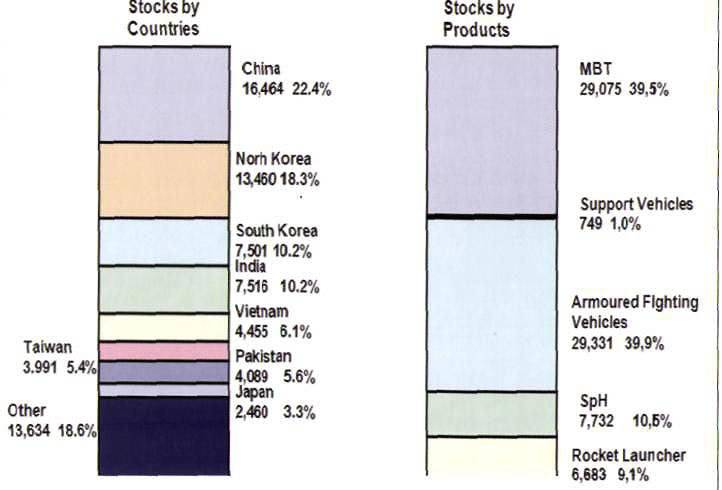
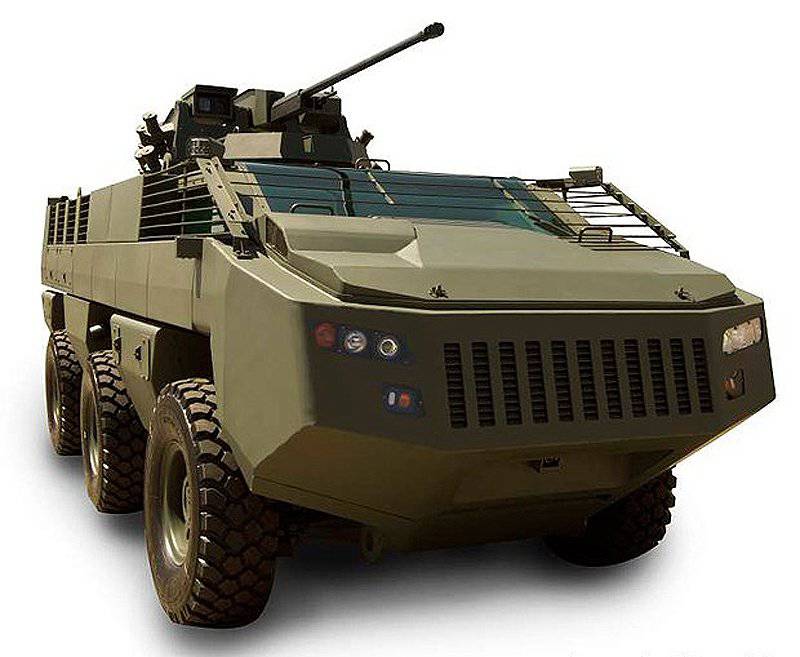
At the African Aerospace and Defense 2010 (AAD) Expo, Paramount showed the MBOMBE 6x6 BMP with a rather flat body (and not with the traditional V-shaped). The honeycomb-shaped flat body allows for a much lower silhouette than modern MRAP, and it is reported that it has better protection against IEDs compared to many of the machines currently used by NATO forces in Afghanistan.
Pakistan
Pakistan's Heavy Industries Taxila manufactures MBT AL-KHALID, developed with the support of China, and is developing a new MBT AL-KHALID II, which entered service in 2012 year. The newly developed 48-ton Chinese OBT Type 90-II has an 125-mm bore gun, automatic loader, improved protection and an 882 kW engine.
Taiwan
In Taiwan, mass production of wheeled armored fighting vehicles CM-32 YUNPAO 8x8 continues according to the stated need for 500 – 600 machines for replacing Type 64 light tanks, tracked BTR M113 and wheeled V-150 BTR.
Middle East and Gulf Area
The Middle East and the Gulf region is characterized by various conflicts and high intensity armed forces with 2,2 millions of soldiers and almost 67000 armored vehicles. Only a few countries, however, like Israel, Jordan, Egypt and Iran have their own armored vehicle industry.
Israel has a sufficient, worldwide, defense industry and strong defense forces of 176500 soldiers. Ground forces have large stocks of 15192 armored vehicles, 3501 MBT, 10847 BBM, 620 SG and 224 rocket launchers. In 2008, the Israeli army bought the first 15 BMP NAMER of the necessary 660 units equipped with a double-action automatic gearbox with a 12,7-mm machine gun or an 40-mm automatic grenade launcher. Based on the MERKAVA OBT chassis, it can carry up to 12 soldiers. NAMER will also be the first BMP in the world equipped with an active protection complex - IMI IRON FIST.
Production approximately 400 MERKAVA 4 for the Israeli army went to 2011 year. The tank has a combat mass of 65 tons, is equipped with the latest protection technology, has a 120-mm bore gun and an 1100 kW engine from MTU.
It is clear that the Israeli army will not deploy a tank MERKAVA 5, since its further development was stopped. At the same time, a program for a lighter OBT, called Rakiya, was launched, but the future will show whether it will survive the Israeli cuts in its defense budget.
Fig. 12: Armored vehicles in the Middle East
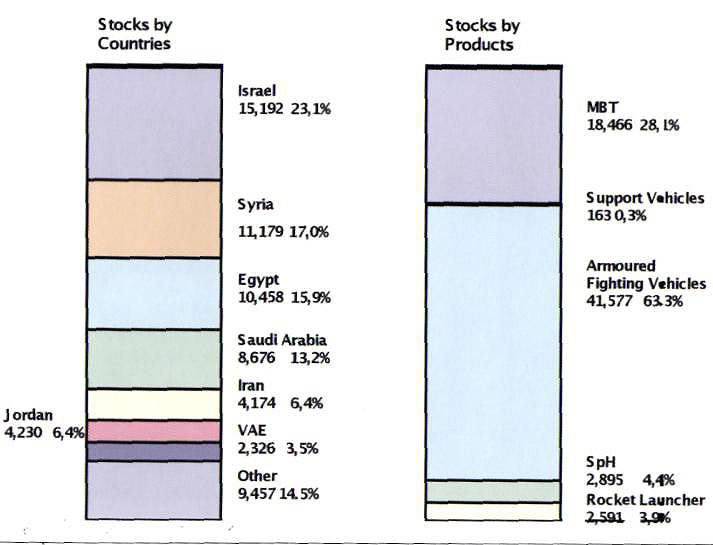
Turkey
Turkey is one of the few countries where new MBTs are being developed. In September 2007, Otokar was selected by the Turkish Defense Ministry’s Defense Industry Secretariat as the main contractor for the Altay project. Phase I. At this stage of 78,5 months, funding was received from the budget in the amount of 500 million dollars, including design and development, prototyping and qualification . Altay Stage I was divided into three sub-steps. Sub-Phase I provided for the creation of a general concept and analysis of system requirements, it began in January of the 2009 year and lasted approximately 18 months. This was followed by Sub-Stage II - the detailed design stage, which included not only the development of working documentation, but also the manufacture of two experimental setups, a Mobile Test Set (MTR) and a Firing Test Set (FTR), the manufacture of which was completed at the end of 2012. The layout of the new tank was officially shown in May 2011, at the IDEF in Istanbul. Sub-stage II was successfully completed in May of the 2013 of the year after the MTR and FTR mileage (each more than 4000 km) and several shooting tests of the FTR unit. These prototypes also underwent severe climatic tests under extreme climatic and relief conditions. Sub-stage III development and qualification of the prototype began in June 2013 of the year. Further testing and optimization of the fire parameters are carried out on the mobile units MTR and FTR, while the production of two experimental machines (PV1 and PV2) is expected to be completed by the middle of the 2014 year. These two prototypes will pass qualification and acceptance tests in the second half of the 2014 year and during the 2015 year. Although the German MTU-Renk power unit is installed in the Altay tank, more than 100 Turkish subcontractors participate in this project. The largest among them is the company Aselsan, which is responsible for a modern computerized fire control system and a battle management system. Roketsan provides booking solutions, while MKE makes the 120-mm L55 smoothbore gun. Otokar develops and manufactures the machine control system and driver display itself. According to the parent company, the qualification tests of the subsystems of these main components are almost complete. It is expected that after completion of Stage I, Stage II will follow, in which mass production is envisaged. It is expected that deliveries of the first batch of 250 tanks will begin at the end of 2016, and will be completed in five years.
Another major Turkish player in the vehicle arena, FNSS, appears to be participating in the “average MBT” project for Indonesia. The company does not comment on information published in the press at the beginning of the year in Indonesia about an agreement at the government level between Jakarta and Ankara on a similar development. It is not clear whether the agreement was formally signed and the work started. The goal of the Indonesian army is to deploy a lighter and more transportable tank compared to 103 tanks Leopard 2A4 ordered from Rheinmetall at the end of 2013, along with logistical support and ammunition.
With sales of 17% (394 million dollars) in turnover and 38% (258 million dollars) in export sales, the land-based platform sector is one of the strongest sectors of the Turkish defense industry. Turkey has traditionally looked at local suppliers in order to meet the requirements for ground platforms of the Turkish Armed Forces. This has allowed the industry to develop a comprehensive range of products, ranging from tactical wheeled armored vehicles (4x4, 6x6 and 8x8), armored reconnaissance vehicles (tracked and wheeled), armored internal security machinery, minozaschischennyh machines, mobile floating assault bridges, machinery riot suppression, floating earthmoving vehicles, armored combat vehicles and MBT ALTAY MW, as well as the modernization and improvement of the BTR, BMP and MBT.
The basis of the Turkish land platform sector is formed by private companies, such as Otokar, BMC, Nurol Machinery, and Hema Industries, as well as FNSS (a private company with a foreign partner), which also occupy the lion's share in the defense sector and export figures. Turkish ground forces military factories, such as 1-th main service center (MMC) in Adapazan and 2-th MMC in Kayseri, play a major role in modernization projects for MBT, such as LEOPARD 1T and M60T and carry out maintenance of tracked and wheeled vehicles in Turkish army.
South Africa
In 2013, BAE Systems ’South African branch completed the delivery of 170 RG32 machines to Sweden. They were purchased under three separate contracts and the total number of vehicles in service with this country reached 370 units. Another Scandinavian country, Finland, received 25 machines in the 2013 year, their total number reached 80 units. Approximately 27 RG32 LTV machines are already in service with Ireland, while a large number of RG32M are involved in UN peacekeeping missions.
The base machine RG32M has a 2,90 meter wheelbase and a ground weight of 7,5 tons in the basic configuration, the maximum weight is 9,5 tons. The car is equipped with a Steyr M16TCA hp turbo diesel engine with 181 horsepower, it houses two crew members plus four or six paratroopers, depending on the installed options. The machine has 1 Level ballistic protection, which can increase to 2 Level due to additional reservation, mine protection withstands the standard DM31 anti-personnel mine.
LTV (light tactical vehicle) has a longer wheelbase 3,34 meter, own weight increased by 1,2 tons due to the elongated cab and increased mine protection to Level 2a / b (ballistic protection remained the same). The machine has a more powerful engine, the Steyr M16SCI turbo diesel engine with 268 horsepower. The standard configuration accommodates two crew members and two paratroopers.
BAE Systems also offers RG34 4x4 with its own mass of 7,5 tons and payload of 2 tons, with ballistic protection of the 2 Level and mine level of 2a / b. It has a crew of two people and seats for six paratroopers. To date, no orders have been received for RG34.
The Convoy Protection Convoy Protection (ICP) integrated protection project includes two families of mini-models Reva III and Reva V, the first of which has a total weight of about 10 tons. Reva III is based on a monocoque V-shaped case, it is available with three wheelbases - 2,27, 3,24 and 3,40 meters and corresponding total masses of 9,1, 9,24 and 10,8 tons. The relatively small difference in the mass between the models Reva SWB and Reva III Standard LWB (respectively 7,4 and 7,95 tons), although the difference in the length of the wheelbases is almost one meter, due to different levels of protection. The Standard LWB model has an 3b anti-mine protection level, and 6 mm thick armor steel sheets provide ballistic protection against improvised explosive devices (VCA) of the B5 Level (i.e. 5,56 and 5,45-mm bullets), while in the SWB model that the same level of mine protection, but protection against IEDs (Level B6 +) is increased by adding additional armor also 6 mm thick to the original sheet of armor steel 6 mm thick. The Long Wheel Base version with increased wheelbase has levels of protection like SWB and its own mass of 9,5 tons. All variants are equipped with a GBT 5.9 155 30 turbo diesel engine with a power of 170 hp. The long base variant accommodates two plus eight, a short base two plus four people. Various variants of the ICP Reva are in service with South Africa and many other countries, including Somalia, Equatorial Guinea, Thailand, Yemen and South Sudan; A number of machines are used by US special units in Iraq.
Future trends
In the future, international crisis management and modern development scenarios will require airmobile armored vehicles on the one hand, and on the other hand, heavier platforms will determine the protection of national sovereignty and freedom. The need for heavy defense and firepower in asymmetrical warfare requires strong armed forces and heavy armored vehicles.
Further development of technologies defining trends, such as protection technology, weapons technology, the development of sensitive elements, the design of autonomous power sources and their implementation in recognizable products, all this determines the competitive strength of the industry of ground systems.
The concentration of the armored vehicle industry, driven by global processes, on the one hand, on the other hand, creates new national opportunities to gain technology and add value, guarantee employment, preserve national independence, and in the export field maintain industrial trends in the global armored vehicle market.
Industrial fragmentation, lack of military harmonization in tactical and technical requirements and financial constraints in the future will also contribute to the expansion of the spectrum and diversity of armored vehicles.
Strategic partnership will be the key to the survival of companies. In many countries, it is no longer possible to preserve national capabilities for creating integrated systems across the entire technological spectrum concerning the development, production and integration of armored vehicles.
For example, a study by the European Defense Agency in 2013 concluded that the European ground machinery sector is more fragmented and less consolidated than manufacturing sectors aviation and marine technology. “It is characterized by overlappings, redundant structures and small batches of products, mainly at the national level,” the report said. “In the current financial climate, this model is more unviable and there is a danger that Europe will lose key opportunities, skills and know-how.”
Materials used:
www.sipri.org
www.monch.com
www.army.mod.uk
www.kmweg.de
www.lockheedmartin.co.uk
www.amgeneral.com
www.rheinmetall-defence.com
www.baesystems.com
www.saabgroup.com
www.gdls.com
www.otokar.com.tr
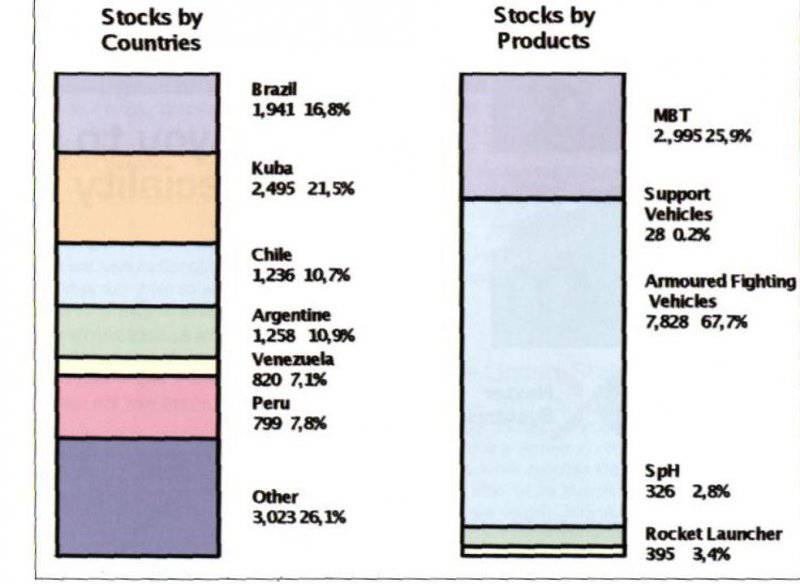
Information